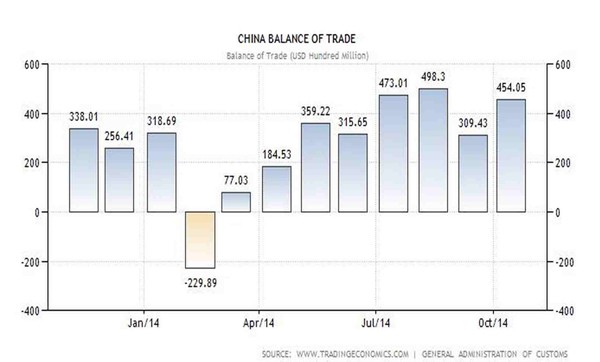China's trade surplus for October is $45.41 billion, the General Administration of Customs said Saturday. This is better than the expected $42.3 billion surplus for the same period, according to a poll survey of 11 economists by The Wall Street Journal.
The $45.41 billion October trade surplus represents a 46.3-percent increase over the same month last year. It is also significantly higher than the $31.0 billion trade surplus recorded in September, but still less than the record $49.8 billion surplus registered in August.
Exports rose 11.6 percent year-on-year in October to $206.87 billion, representing a slowdown when compared with the 15.6-percent year-on-year increase in September.
According to Trading Economics, China's October sales to the United States grew by 10.9 percent (as against the 10.8 percent in September); exports to the ASEAN countries increased by 18 percent, and those to South Korea by 13.8 percent.
Shipments of goods and services to the European Union slowed to 4.1 percent from the 14.9 percent in September, while those made to Japan slowed down even faster at 8.1 percent as against the -5.3 percent in the previous month.
Imports, on the other hand, reportedly grew at just 4.6 percent year-on-year to $161.46 billion in October, a marked deceleration when compared with the 7-percent year-on-year increase in September.
As gathered by Trading Economics, imports from South Korea--which grew 12.6 percent in October as against 27.8 percent in September--and the United States--which increased 2.2 percent versus 12.6 percent the previous month--eased the most. In contrast, October purchases of goods and services coming from the European Union increased 10.4 percent as against the 9.1 percent in September.
Liu Xuezhi, a Shanghai-based analyst at Bank of Communications, noted that "the trade surplus was driven by the contraction in growth of imports . . . and export growth was not very strong. So the quality of the surplus was not very high."
Beginning 1995, China has consistently realized trade surpluses. From 2004 to 2009, China's annual trade surplus has increased 10 times, according to Trading Economics. However, since then, it has been showing signs of decline both in terms of magnitude and rates of increase.
In the last few years, the biggest trade surpluses were recorded with the United States, the Netherlands, the United Kingdom, Vietnam and Singapore.
The biggest trade deficits were recorded with Taiwan, South Korea, Australia, Germany, South Africa, Japan and Brazil.



























